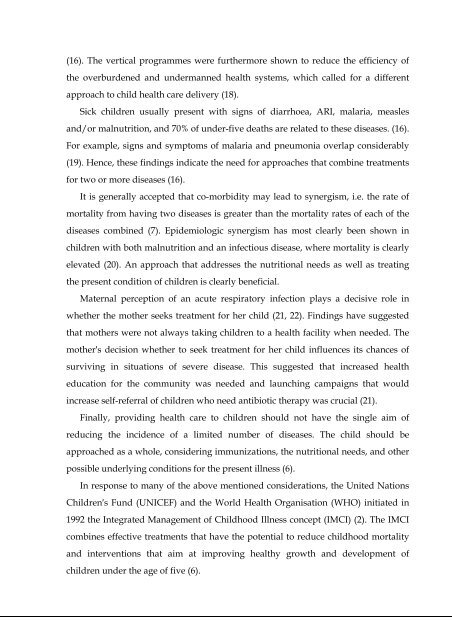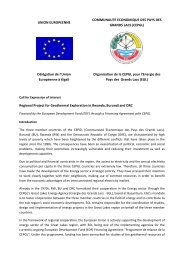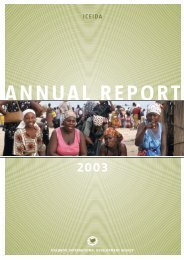The Implementation of Integrated Management of Childhood Illness ...
The Implementation of Integrated Management of Childhood Illness ...
The Implementation of Integrated Management of Childhood Illness ...
Create successful ePaper yourself
Turn your PDF publications into a flip-book with our unique Google optimized e-Paper software.
(16). <strong>The</strong> vertical programmes were furthermore shown to reduce the efficiency <strong>of</strong><br />
the overburdened and undermanned health systems, which called for a different<br />
approach to child health care delivery (18).<br />
Sick children usually present with signs <strong>of</strong> diarrhoea, ARI, malaria, measles<br />
and/or malnutrition, and 70% <strong>of</strong> under-five deaths are related to these diseases. (16).<br />
For example, signs and symptoms <strong>of</strong> malaria and pneumonia overlap considerably<br />
(19). Hence, these findings indicate the need for approaches that combine treatments<br />
for two or more diseases (16).<br />
It is generally accepted that co-morbidity may lead to synergism, i.e. the rate <strong>of</strong><br />
mortality from having two diseases is greater than the mortality rates <strong>of</strong> each <strong>of</strong> the<br />
diseases combined (7). Epidemiologic synergism has most clearly been shown in<br />
children with both malnutrition and an infectious disease, where mortality is clearly<br />
elevated (20). An approach that addresses the nutritional needs as well as treating<br />
the present condition <strong>of</strong> children is clearly beneficial.<br />
Maternal perception <strong>of</strong> an acute respiratory infection plays a decisive role in<br />
whether the mother seeks treatment for her child (21, 22). Findings have suggested<br />
that mothers were not always taking children to a health facility when needed. <strong>The</strong><br />
mother′s decision whether to seek treatment for her child influences its chances <strong>of</strong><br />
surviving in situations <strong>of</strong> severe disease. This suggested that increased health<br />
education for the community was needed and launching campaigns that would<br />
increase self-referral <strong>of</strong> children who need antibiotic therapy was crucial (21).<br />
Finally, providing health care to children should not have the single aim <strong>of</strong><br />
reducing the incidence <strong>of</strong> a limited number <strong>of</strong> diseases. <strong>The</strong> child should be<br />
approached as a whole, considering immunizations, the nutritional needs, and other<br />
possible underlying conditions for the present illness (6).<br />
In response to many <strong>of</strong> the above mentioned considerations, the United Nations<br />
Children′s Fund (UNICEF) and the World Health Organisation (WHO) initiated in<br />
1992 the <strong>Integrated</strong> <strong>Management</strong> <strong>of</strong> <strong>Childhood</strong> <strong>Illness</strong> concept (IMCI) (2). <strong>The</strong> IMCI<br />
combines effective treatments that have the potential to reduce childhood mortality<br />
and interventions that aim at improving healthy growth and development <strong>of</strong><br />
children under the age <strong>of</strong> five (6).<br />
11
















